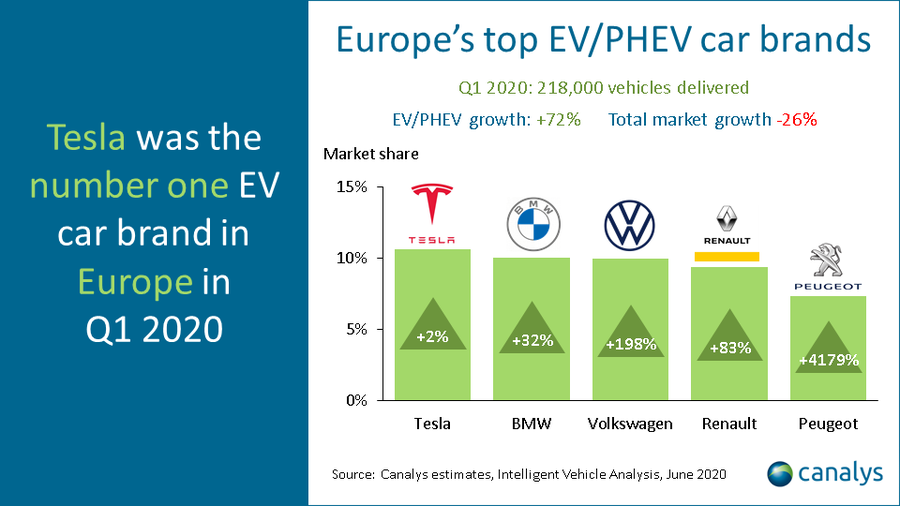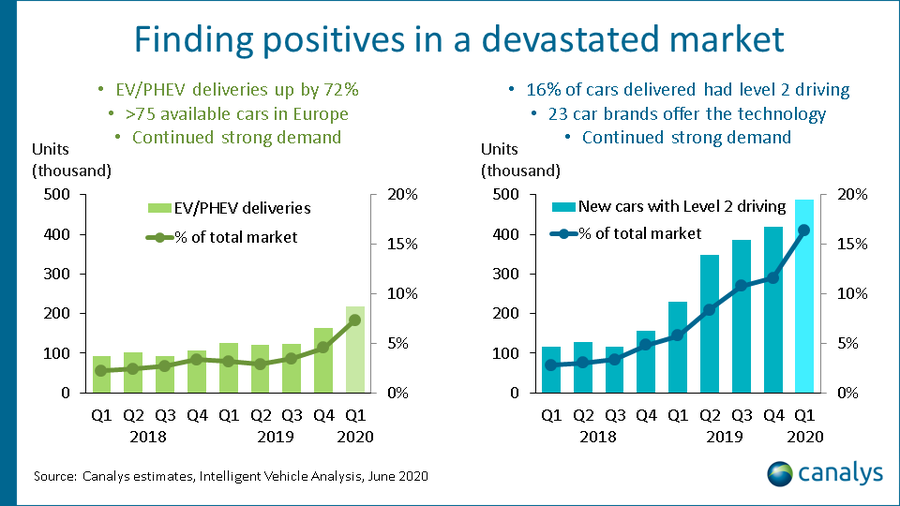
Deliveries of new cars fell 26% in Europe in Q1 2020 compared with Q1 2019. Some 3 million new cars were delivered, down by a million since Q1 2019. But at the same time the European market for electric vehicles (EVs) and plug-in hybrid electric vehicles (PHEVs) grew by 72% to represent over 7% (218,000) of all new cars delivered.
A domino effect of COVID-19-related measures devastated the car industry over a matter of weeks in the first quarter of 2020. As lockdowns came into effect in parts of Asia, the supply of key components dried up. Then car manufacturing stopped around the world, dealerships and showrooms closed and car use fell to a bare minimum.
“The impressive EV results could have been even better,” said Chris Jones, Chief Analyst for the automotive sector at Canalys. “Demand for EVs outstripped supply and there are long waiting lists and lead times for new high-profile EVs. Some automotive OEMs were forced to delay launches and some even kept older EVs on the market to satisfy demand – the VW e-Golf had a record sales quarter in Europe. Government incentives and trade-in schemes will mean substantial discounts on new EVs – all good news as dealerships reopen and the market picks itself up.”
The range of vehicles has improved significantly in Europe. There are currently more than 75 EVs and PHEVs available in Europe, with more on the way. The Tesla Model 3 led sales with over 20,000 deliveries in Q1, while the most successful of the newly launched models was the Peugeot e-208. “Many popular compact cars in Europe, like the 208, will have an EV variant in 2020. This familiarity will help boost sales.”
Despite the lockdowns only happening in the latter weeks of Q1 in most of Europe, new car deliveries fell by a staggering 26%. Just 3 million cars were delivered, a drop of a million from the same period in 2019. The rise in unemployment, economic uncertainty and ongoing lockdown and travel restrictions, as discussed by Canalys in April, will make 2020 a particularly tough year for the automotive industry.
More driver assistance technology
There were positives in moves toward safer roads. Nearly 490,000 new cars, representing 16% of deliveries in Q1 2020 in Europe, had level 2 driver assistance systems. Level 2 driving systems use an array of sensors and cameras and, along with other driver assistance features, aim to deliver a more comfortable, safer driving experience.
The systems keep a vehicle in its lane (by applying steering support) and maintain a safe distance from the vehicle in front (by accelerating and braking). “Level 2 driving systems are no longer confined to premium cars. 23 car brands, including many mainstream brands, now include the feature as an available option or as a standard feature in their new cars in Europe,” said Jones. “We are now seeing clear segmentation in the available systems. The latest, more advanced systems provide an enhanced 360-degree view of a car’s surroundings, can anticipate upcoming speed changes, can enable overtaking and can sense when hands are not on the steering wheel.”







